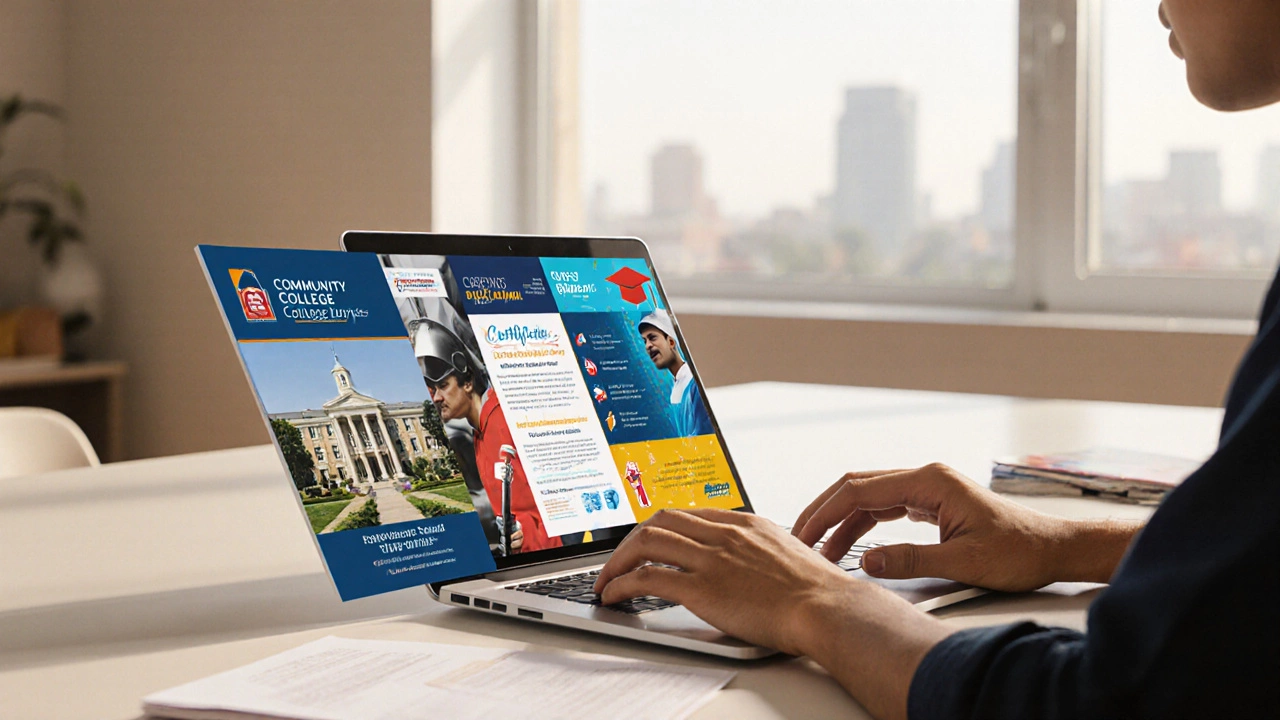How to Obtain a Diploma in the USA: Step‑by‑Step Guide for International Students

US Diploma Cost Calculator
Diploma Program Cost Estimator
Your Estimated Costs
Tuition
$0.00
Housing
$0.00
Insurance & Books
$0.00
Total Estimated Cost
$0.00
Note: This estimate includes tuition, housing, health insurance, books, and daily living expenses. Actual costs may vary based on individual circumstances and location.
When you hear Diploma in USA is a credential offered by colleges, trade schools, and vocational institutes that certifies completion of a specific program of study, you probably wonder how to actually earn one, especially if you’re coming from abroad. The process may seem daunting, but breaking it down into clear steps makes it manageable. Below is a practical roadmap that covers everything from choosing the right program to landing your student visa, so you can focus on the learning, not the paperwork.
1. Know What Kind of Diploma You Want
In the United States, a “diploma” can mean a few different things. Most international students aim for one of the following:
- Associate‑degree diploma - typically a two‑year program offered by Community Collegea publicly funded two‑year institution that provides associate degrees, diplomas, and certificates. Fields range from business and IT to health sciences.
- Career‑specific diploma - programs that focus on a trade or technical skill, such as welding, graphic design, or culinary arts. These are often shorter (6‑12 months) and offered by vocational schools.
- Certificate program - similar to diplomas but usually more specialized, like a Certificate in Digital Marketing. While not a full diploma, many treat it as a stepping stone.
Decide early which path aligns with your career goals because it determines the admission criteria, cost, and duration.
2. Check Accreditation and Program Quality
Accreditation is the U.S. quality‑control stamp. Only schools recognized by a regional or national accrediting agency can issue credentials that employers and further‑education institutions respect. Look for statements such as “Regionally accredited by the Middle States Commission on Higher Education” on the school’s website.
Why it matters:
- It affects visa eligibility - U.S. immigration only approves students at accredited institutions.
- It influences credit transfer if you later pursue a bachelor’s degree.
- It often determines eligibility for federal or state financial aid (though many international students don’t qualify, some private scholarships do).
3. Meet Academic and Language Requirements
Most diploma programs require a high‑school diploma or equivalent. As an international applicant, you’ll need to prove academic readiness and English proficiency.
- Standardized Teststandardised English language exams such as TOEFL or IELTS required for non‑native speakers. Typical minimum scores: TOEFL iBT 71, IELTS 5.5.
- Some schools also ask for a GEDGeneral Educational Development test equivalent to a U.S. high‑school diploma if your home country’s secondary certificate isn’t recognized.
- Transcripts must be translated into English and evaluated by a credential‑evaluation service (e.g., World Education Services). This adds credibility to your academic record.

4. Choose a School and Program
Use these criteria to shortlist schools:
- Accreditation status and program reputation.
- Location - big cities often have higher living costs but more internship opportunities.
- Tuition and fees - community colleges typically charge $3,000‑$8,000 per year for international students.
- Support services - look for an International Student Office that provides visa assistance and cultural orientation.
- Optional: Availability of Scholarshipfinancial awards that reduce tuition for eligible students or tuition waivers.
For quick comparison, see the table below.
| Program Type | Typical Duration | Average Tuition (USD) | Key Careers | Accreditation Needed |
|---|---|---|---|---|
| Associate‑Degree Diploma | 2 years | $4,500‑$8,000 per year | Healthcare tech, IT support, Business admin | Regional |
| Career‑Specific Diploma | 6‑12 months | $3,000‑$6,000 total | Welding, Culinary arts, Graphic design | National or program‑specific |
| Certificate Program | 3‑9 months | $2,500‑$5,000 total | Digital marketing, Data analytics | Often none, but check employer acceptance |
5. Apply and Secure Your Spot
Application steps are similar across most institutions:
- Create an online account on the school’s admission portal.
- Upload required documents: passport copy, English test scores, evaluated transcripts, personal statement, and any program‑specific prerequisites (e.g., a portfolio for design).
- Pay the non‑refundable application fee (usually $50‑$100).
- Wait for the admission decision. Most schools reply within 4‑6 weeks for international applicants.
- Once accepted, you’ll receive an I‑20 FormCertificate of Eligibility for Non‑immigrant Student Status issued by a U.S. school. Keep this safe - it’s needed for your visa.
6. Obtain a Student Visa (F‑1)
The most common visa for diploma‑seeking students is the F‑1. Follow these steps promptly after receiving your I‑20:
- Pay the SEVIS I‑901 fee (currently $350).
- Complete the DS‑160 online non‑immigrant visa application.
- Schedule a visa interview at the nearest U.S. Embassy or Consulate. Bring your passport, I‑20, DS‑160 confirmation page, SEVIS fee receipt, and financial proof (bank statements, sponsor letters).
- During the interview, demonstrate your intent to study, ties to your home country, and ability to cover tuition plus living costs (generally $15,000‑$20,000 per year for community college students).
- If approved, the consular officer stamps your passport with the F‑1 visa. You can now book travel.
Tip: Arrive in the U.S. up to 30 days before classes start - no earlier, as the F‑1 entry window is limited.

7. Plan Your Finances
Tuition isn’t the only expense. Budget for:
- Housing - on‑campus dorms cost $3,500‑$6,000 per semester; off‑campus rentals vary widely.
- Health insurance - most schools require a mandatory plan (~$800 annually).
- Books and supplies - $500‑$1,000 per year, depending on program.
- Daily living (food, transport) - $10‑$15 per day on average.
Explore Scholarshipfinancial aid options offered by schools, private foundations, or government programs for international students. Many community colleges have merit‑based awards that can shave off 10‑20% of tuition.
8. Prepare for Arrival and Success
Before you jet off, take care of a few practical matters:
- Set up a U.S. bank account - many banks let you open an account with just a passport and address verification.
- Obtain a mobile phone plan - prepaid options are cheap and work for the first few months.
- Register with the school’s International Student Office - they’ll help you with orientation, SEVIS updates, and any work‑authorization questions.
- Know the work limits - F‑1 students can work up to 20 hours/week on‑campus, and later apply for CPT/OPT for off‑campus experience related to studies.
Finally, immerse yourself. Join student clubs, attend career fairs, and use the school’s career services. A diploma opens doors, but networking often decides which door swings wide open.
Frequently Asked Questions
Can I get a diploma in the USA without a high‑school diploma?
Most schools require a high‑school credential, but a GED or an evaluated equivalent from your country often works. Some vocational programs may accept work experience in place of formal education, but you’ll need to confirm with the institution’s admission office.
How long does the F‑1 visa process take?
After you receive the I‑20, the SEVIS fee and DS‑160 can be completed in a day. Visa interview appointments vary by location - in busy embassies it may be 2‑4 weeks. Overall, allow 6‑8 weeks from acceptance to visa stamping.
Are there scholarships for international students at community colleges?
Yes, though they’re fewer than at four‑year universities. Look for merit‑based awards, community‑service scholarships, or country‑specific funds offered by the school’s International Student Office.
Can I work while studying for my diploma?
On an F‑1 visa you can work up to 20 hours per week on‑campus during the semester. After completing your first academic year you may be eligible for Curricular Practical Training (CPT) or Optional Practical Training (OPT) for off‑campus experience related to your field.
What if I want to transfer my diploma credits to a bachelor’s program?
Most regionally accredited community colleges have articulation agreements with four‑year universities. After you earn your associate‑degree diploma, you can apply to a bachelor’s program and typically enter as a junior, provided your credits align with the target school’s curriculum.

Post-Comment